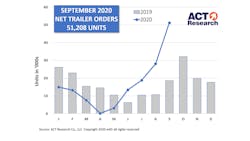September net US trailer orders of 51,208 units were a significant improvement (up 82%) from August’s uptick and well above September 2019’s level (up 174%) according to this month’s issue of ACT Research’s State of the Industry: U.S. Trailer Report. Before accounting for cancellations, new orders of 52,000 units were up 77% versus August and 140% better year-over-year.
“The confluence of several factors is evident in September’s third-highest monthly net volume in history,” said Frank Maly, director–CV Transportation Analysis and Research at ACT Research. “Pent-up demand is one factor, as we’re now seeing capex release that was curtailed earlier this year by COVID-driven uncertainty. Another factor is lower build rates, pushing fleets to quickly submit their orders, rather than take a chance that new units might not be delivered until well into next year.”
In addition to fleets, dealers could also be worrying about the timing of stocking orders, Maly added.
“Conversations have included mention of dealers entering the fray in preparation for next yearm” he said. “Further solid numbers are likely in the near-term, as the industry enters what has normally been its usual ‘order season’.”
ACT Research’s State of the Industry: U.S. Trailers report provides a monthly review of the current US trailer market statistics, as well as trailer OEM build plans and market indicators divided by all major trailer types, including backlogs, build, inventory, new orders, cancellations, net orders, and factory shipments. It is accompanied by a database that gives historical information from 1996 to the present, as well as a ready-to-use graph packet, to allow organizations in the trailer production supply chain, and those following the investment value of trailers and trailer OEMs and suppliers, to better understand the market.
Additionally, ACT Research recently announced plans for a new multi-client study focusing on electrification of the commercial vehicle industry to be released in 2021. The scope of the study will include unit sales for the US and Canada, annually from 2020 to 2030, with single-year outlooks for 2035 and 2040. Class 8 truck and Classes 4-7 truck and bus segments will be considered, with additional segmentation encompassing step vans, conventional and low cab forward trucks, RV, school bus, yard spotter, transit bus categories, as well as the Class 8 straight, day cab, and sleeper subcategories.
The research will compare purchase and operational costs for diesel, battery, fuel cell, and hybrid powertrains in a rigorous comparative total cost of ownership (TCO) framework. It will also take into account concerns, such as infrastructure requirements and costs, regulation, and issues including maintenance, range, durability and vehicle and component replacement.
For more details about how to participate in this study, including a full prospectus, contact Ian McGriff at [email protected] or click here.
